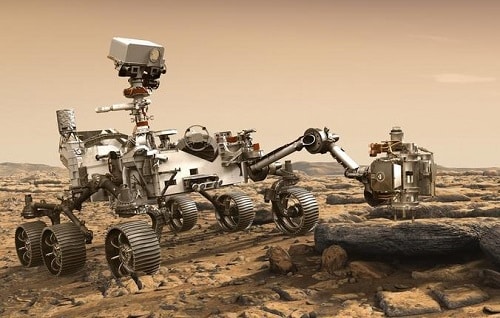Integrating advanced innovative technology to pave the way for future human exploration of the solar system

On a mission to search for traces of ancient microbial life, the advanced planetary rover called Perseverance is currently researching Mars by collecting drill-core samples and performing experiments. Being 130 million miles away, the message to reach Earth takes around 11.5 minutes.
Its entry into the red planet’s thin atmosphere at 11,900 mph was not easy; filled with challenges of deep space high energy radiation and extreme heat and cold cycling. Armed with hardened technology, the 2,300 pounds robotic scientist will help pave the way for future human exploration of our solar system.
To push the boundaries of technology, Analog Devices, Inc. (ADI) has drawn on the power of innovation and collaborated with NASA/JPL to develop components and systems that can withstand the extreme G-forces of launch and meet the stringent quality standards to survive in the harshest conditions of space. The Perseverance Mission is yet another technical collaboration and space milestone for NASA/JPL and ADI.
The six-wheeled robotic rover will search for chemical, mineral, and textural evidence of ancient microbial life preserved in the crater’s sediments.
Powering The Mission
Electricity is the lifeblood powering the robotic explorer’s instrumentation, communications, mobility and scientific activities. Reliable power and battery longevity are critical to the 11-year rover mission. Perseverance runs on a high voltage battery bus for efficiency. However, the voltage output provided directly from the bus is too high for 99% of the Martian explorer’s electronic systems. Without an efficiently regulated intermediate voltage step-down, the rover would waste a significant amount of energy and the battery would require more frequent recharging.
Power Collaborator
NASA/JPL and ADI deliver key power management solutions. The high voltage, synchronous, current-mode controller acts as an interface to transform the high voltage supply from the central battery bus to lower voltages required to run all the rover’s components (ICs). The radiation-hardened controller offers the highest levels of conversion efficiency while wasting as little power as possible. Power loss generates heat and excess heat is detrimental to component health. And in the thin Martian atmosphere, it’s even more challenging to get rid of any excess heat.
Setting The Stage For The Bigger Mission
The Mars 2020 rover carries several experiments focused on missions yet to come. Mars Oxygen In-Situ Resource Utilization Experiment (MOXIE) will test a method for extracting oxygen from Mars’ thin atmosphere. MOXIE will demonstrate if converting Martian carbon dioxide into oxygen is within the realm of possibility. If successful, future versions of MOXIE’s technology may become staples on other Mars missions, providing oxygen for rocket fuel and breathable air for future explorers and inhabitants. Also travelling with Perseverance is Ingenuity. The solar-powered helicopter drone will test flight stability in Mars’ thin atmosphere—one-hundredth of Earth’s—and scout for the best locations for exploration and the safest rover driving routes.
History Of Hardened Technology
Sixty-three ADI components critical to the Mars mission lie aboard the Perseverance. “The parts span the realm of RF/μW to op-amps, power management to data conversion and everything in between,” said Kristen Chong, Marketing Manager and Applications Engineer, ADI. “We continue to work with NASA/JPL on challenging new space programs.”
With a working relationship dating back to the early 1980s, ADI has been pushing the limits of technology and developing critical components, custom programs and hardened technology with NASA/JPL. Regardless of its function or mission, each component encounters the harshest conditions, including extreme G-forces, vibration, temperature fluctuation, and radiation.
After almost 20 years in service, ADI’s AD590S continues to gather temperature data. As a testament to its operation record, the AD590S was selected by NASA/JPL for the 2020 Perseverance mission.
Radiation’s Deleterious Effects
Spacefaring vehicles that travel beyond the protection of Earth’s magnetic field are subjected to the harmful effects of radiation emitted by the Sun. Radiation can produce random errors, reset processing devices, and even destroy components. Radiation’s effects include:
- Single-event effects (SEE): a single ion or particle hitting a specific region of a device that results in a variety of odd phenomenon and errors.
- Total ionizing dose (TID): long-term cumulative effects that ionizing radiation has on parts throughout their operating lives. TID may result in offset shifts such as increased supply current on some components.
- Displacement damage (DD): large particles such as neutrons that can break down a silicon chip’s crystal structure, causing physical damage.
Quality Control, Performance and Longevity
For over 40 years, ADI has collaborated with NASA/JPL to develop hardened technology to withstand space’s harshest environments. These components have not only performed flawlessly but in many cases, exceeded all expectations, lasting years or even decades longer than prescribed by mission requirements.
The relationship’s longevity speaks to a continued trust by NASA/JPL in the products we build, our testing rigours, and the quality and standards we uphold. It also gives testament to ADI’s on-site services, deep domain expertise, and technologies that cross generations of space missions.
ADI’s standards and values represent proof points to our terrestrial-based customers with less demanding applications as well. Knowing that specific components are qualified to endure decades in the harshest space environments adds a level of reliability and trust that they will function faultlessly on Earth—whether it’s in a manufacturing plant, an electric vehicle, or a hospital surgical suite.
The Perseverance rover mission, and the many missions to follow, are only one small part of a grander program. NASA is charged with returning astronauts to the Moon by 2024, with a plan to establish a sustained human presence by 2028 in preparation for human exploration of Mars. It is ADI’s resolve to be part of that great exploration.






